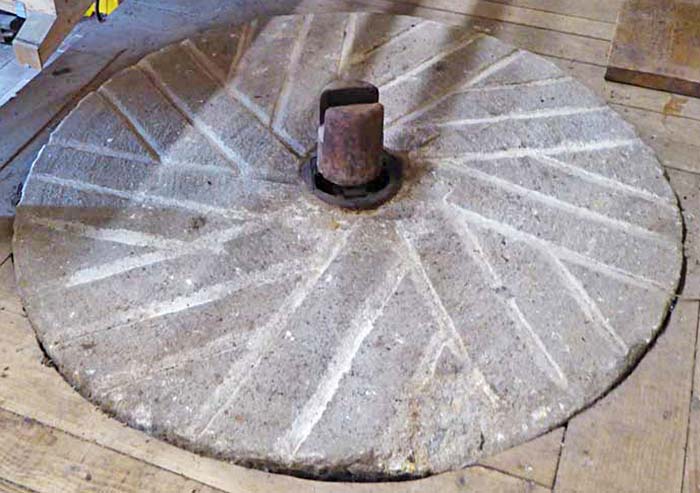
Millstone Types: Millstone Grit
A coarse British sandstone
AKA British Peak Stones, Grey Stones, Gritstone, Devonshire Grit
Singleton Mills homepage > Overview of Stone types used for Millstones > British Millstone Grit millstones
Millstones from Millstone Grit
Abrasive millstones made from Millstone Grit or Gritstone were extensively used for grinding grains, especially wheat, in early British flour mills. Millstone Grit was also used to make grindstones for sharpening steel.

Above, an old Millstone Grit or gritstone millstone, mounted as a bed stone, at Acorn Bank Watermill in Cumbria, England. Photograph courtesy of Martin Fagan and the Trustees for Acorn Bank Watermill.
Millstone Grit is a coarse-grained sandstone that occurs in northern England, northeast Wales, and northwest Ireland. The most widely produced millstones in the United Kingdom, known as 'Peak Stones' or 'Grey Stones', came from outcrops of this stone, especially in the Peak District in Derbyshire, but also in Lancashire and West Yorkshire. There are records of quarrying millstones in the Derbyshire Peak District from as early as the 1200s AD.
Spectacular evidence of this early quarrying work can be seen in the remains of many hundreds of millstones and grindstones, many virtually complete, left standing in quarries in the Peak District in England, when they were abandoned.

Above, some of the estimated 1,500 millstones and grindstones that lie abandoned in the Peak District of Derbyshire, UK. These ones are below the rocky outcrops of Stanage Edge. Photograph by Neil Theasby. Wikimedia Commons.
Millstone Grit composition
Millstone Grit is an abrasive, coarse-grained sandstone rich in small white quartz pebbles (up to 10 mm wide). It contains varying amounts of feldspar.A When it was used for millstones, this Millstone Grit tended to wear relatively quickly, compared with more-preferred millstone types such as French Burr Stones. This abrasion left an undesirable gritty residue in the flour. So, by the 1700s Millstone Grit millstones were mainly used to grind animal feed rather than flour.
A: Feldspar. This is a group of minerals containing aluminium and silica. It is the most abundant mineral group on earth.

Above, detail of a rather coarse-grained variety of Millstone Grit stone from Bolton, Lancashire, UK. These irregularly-shaped grains have good abrasive qualities for grinding. The full width of this image shows a 20mm-wide section of the stone. Macro image by Anne Dollin.

Above, detail of a reddish-coloured, slightly finer-grained variety of Millstone Grit stone from Derbyshire, UK. The full width of this image shows a 20mm-wide section of the stone. Macro image by Anne Dollin.
Replaced by imported millstones
The demand for Millstone grit Millstones declined during periods when basalt Cullin millstones from Germany, or later, French Burrstones from France were available as imports.
SOURCES INCLUDE:
1. Apling 1984:16 in Hockensmith, Charles D (2009) The Millstone Industry. McFarland and Company, Inc, Publishers, page 160.
2. Shaffrey, Ruth (2021) Supplementary material in Feeding Roman Silchester: Querns and Millstones in and around Roman Towns. Britannica, Vol 52, Cambridge University Press.
3. Ingle, Caroline Jane (1989) Characterisation and distribution of beehive querns in eastern England. PhD Thesis. University of Southampton.
4. Polak, JP (1987) The production and distribution of Peak millstones from the sixteenth to the eighteenth centuries. Derbyshire Archaeological Journal, 107: 55-72.
Read More About Millstones
•• Overview •• French Burr Stones •• Basalt-like Cullin Stones •• Old Red Sandstone, Puddingstone, and Lodswoth Stone •• Granite •• Limestone •• Artificial Millstones •• Norfolk Island Millstones •• Colonial Millstones ••